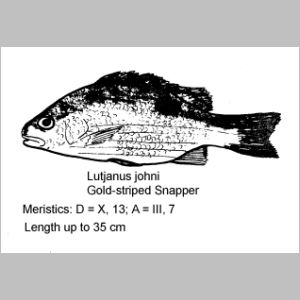Bulletin 6 - December 1978: Fishes of Abu Dhabi - Part 4
Fishes of Abu Dhabi - Part 4
by Roger BrownIn this part of the continuing series, we take a look at two more fish quite common to this area: Amphiprion ocellaris and Lutjanus johni.
Amphiprion ocellaris
Commonly known as "Orange Clown Fish" or "Orange Anemone Fish", Amphiprion ocellaris is quite a remarkable little fish both for its coloring and its habits. Amphiprion ocellaris takes its common names from the rather comical way in which it swims and its unusual habits.
DescriptionAmphiprion ocellaris is a very brightly colored fish. Its body is orange and is marked with three vertical wavy white bands. The dorsal spines and rays combine to form one continuous fin. The pectoral and ventral fins are relatively large and rounded. All fins have dark fringes. Amphiprion ocellaris grows to a length of approximately 10 cm.
Habits and HabitatAny suitably sized anemone can provide the perfect habitat for Amphiprion ocellaris. The fish makes its home among the anemone's stinging tentacles. Any other fish would perish in such an environment but the anemone fish is immune due to a special mucus fluid secreted through its body scales.
A special relationship exists between the fish and its host. Food for the anemone comes in the form of leftovers from the fish's prey. The Clown Fish attracts inquisitive prey with a rather comical swimming display in and around the anemone's tentacles. The prey, believing the Clown Fish to be in difficulty and thus an easy meal, ventures into the stinging tentacles and is captured by both fish and anemone.
When away from the host plant, Amphiprion ocellaris swims with a jerky up and down movement.
Amphiprion ocellaris has been observed in shallow waters about two kilometers out from Batin beach, and in deeper waters near the Zakum oilfield.
Lutjanus johni
Commonly known as "Gold Striped Snapper", and in Arabic as "Nisar", this fish can quite often be seen around rocks or corals. It is a rather sleek fish and quite attractive.
DescriptionLutjanus johni has a silvery, perch-like body with a number of horizontal gold bands running along the lower half. There is a black spot just below the dorsal ray. This spot is very prominent in the juvenile fish. This eye-like spot is thought to confuse would-be predators and allow Lutjanus johni to escape from awkward situations. The fins are a pale yellow color, and the mouth is rather large in comparison with the rest of the body. Lutjanus johni grows to about 35 cm in length.
Habits and HabitatLutjanus johni prefers a rocky or coral cave in which to hide and wait for easy prey to pass by.
The juvenile fish is not so territorial, preferring to hunt for food in small groups. Lutjanus johni is not fussy about what it eats and its source of food is any small creature it can get into its large mouth.
Gold Striped Snappers have been seen around the many rocky and coral areas of Abu Dhabi. An easy place to observe this fish is from the Corniche/Hilton breakwater. The breakwater seems to have become a breeding ground for many small fish and small groups of Lutjanus johni can often be noticed swimming around the rocks.

